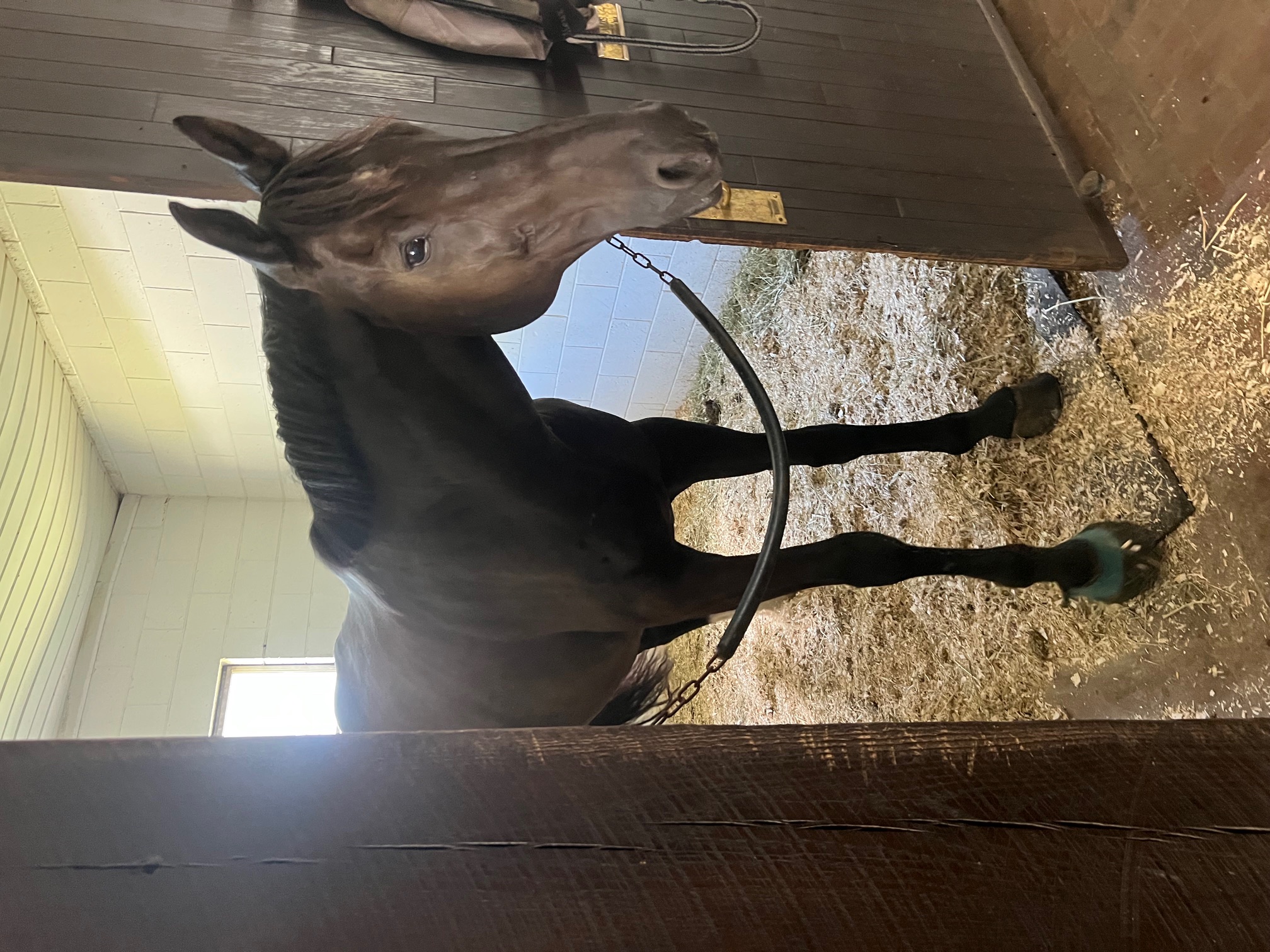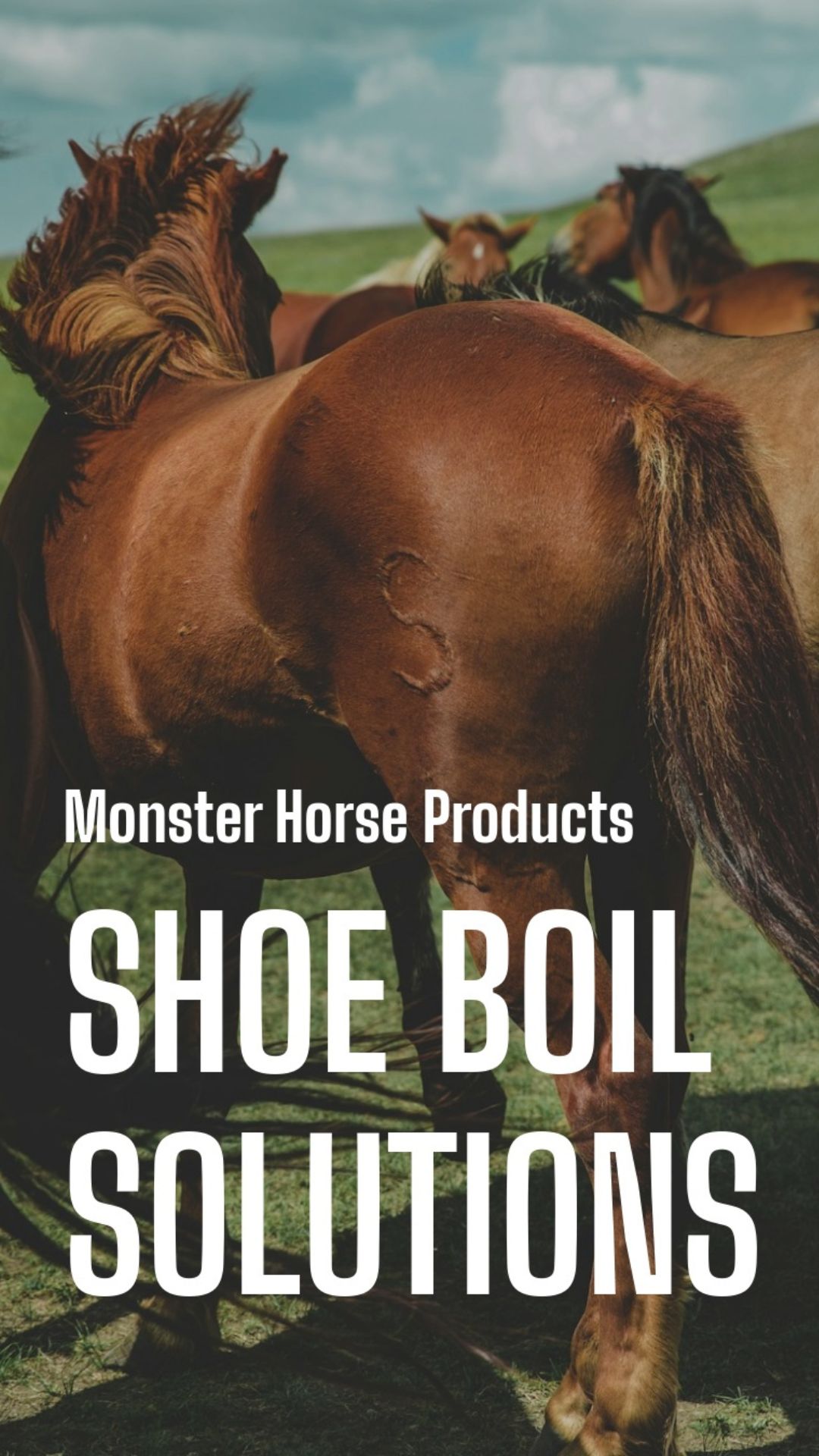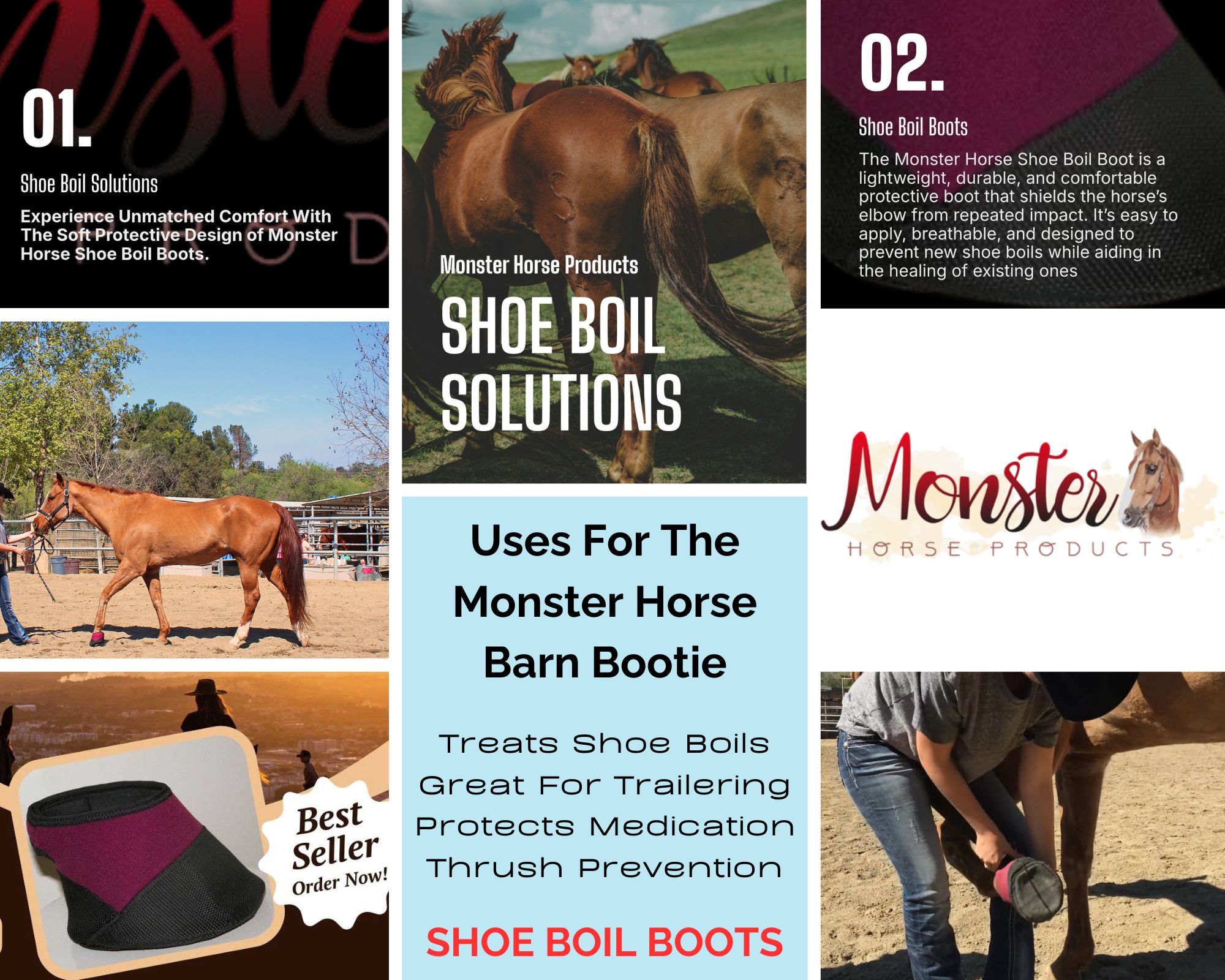Healthy Hooves & Beyond
Monster Featured Friends

Aramis says thank you for the boot.
It fits like a glove, he loves wearing it and the shoe boil is looking under control.
We appreciate all your help Kim.
- Lidiya and Aramis
Tewksbury NJ
Shoe boils, also known as olecranon bursitis or capped elbows, are common in horses, especially those that spend significant time lying down on hard surfaces. These fluid-filled swellings at the point of the elbow can cause discomfort and, if left untreated, may lead to more severe complications. Understanding the causes, treatments, and preventive measures is essential for maintaining your horse's health and comfort.
🔍 Understanding Shoe Boils
What Are Shoe Boils?
Shoe boils are swellings that develop over the olecranon bursa, located at the point of the horse's elbow. They result from repeated trauma or pressure, often when a horse lies down and the heel of its shoe or hoof contacts the elbow region. Over time, this pressure leads to inflammation and fluid accumulation in the bursa.
Causes and Risk Factors
-
Hard Surfaces: Stalls with inadequate bedding can increase pressure on the elbow when the horse lies down.
-
Improper Shoeing: Long-heeled shoes can exacerbate contact between the hoof and elbow.
-
Conformation: Certain conformational traits may predispose horses to develop shoe boils.

💊 Effective Treatments for Shoe Boils
Non-Invasive Treatments
-
Cold Therapy: Applying cold packs can reduce inflammation in the early stages.
-
Anti-Inflammatory Medications: Non-steroidal anti-inflammatory drugs (NSAIDs) can alleviate pain and swelling.
-
Protective Gear: Using devices like the Monster Shoe Boil Boot can prevent further trauma by cushioning the elbow area.
Medical Interventions
-
Aspiration: In some cases, a veterinarian may drain the accumulated fluid to reduce swelling.
-
Corticosteroid Injections: These can be administered to decrease inflammation within the bursa.
-
Surgical Options: For chronic or severe cases, surgical removal of the bursa may be considered.
🛡️ Preventing Shoe Boils
-
Adequate Bedding: Ensuring stalls have sufficient, soft bedding can minimize pressure on the elbows.
-
Proper Shoeing: Regular consultations with a farrier to maintain appropriate hoof length and shoeing can prevent undue contact.
-
Use of Protective Equipment: Implementing tools like the Monster Shoe Boil Bracelet can offer continuous protection against trauma. monsterhorseproducts.com
Snag The Monster Horse Barn Bootie - Watch The Video of This Shoe Boil Boot In Action!
🐎 Real-Life Success Stories
Many horse owners have found success in preventing and treating shoe boils using Monster Horse Products. For instance, the Monster Shoe Boil Boot has been praised for its lightweight design and effectiveness in cushioning the elbow area, leading to reduced incidence of shoe boils.
📝 Conclusion
Shoe boils are a manageable condition with the right knowledge and tools. By understanding their causes, implementing effective treatments and taking preventive measures, you can ensure your horse remains comfortable and healthy. Explore products like the Monster Shoe Boil Boot and Bracelet to provide your horse with the best protection against shoe boils.
For more information and to explore our range of protective gear, visit Monster Horse Products.
Shoe boils—also known as olecranon bursitis or capped elbow—might not seem like a big deal at first, but if left untreated, they can become a persistent, painful, and unsightly problem for your horse. Whether you’re dealing with a chronic case or want to prevent the issue altogether, this guide offers everything you need to know—plus, introduces you to the Monster Shoe Boil Boot, a game-changer in horse care!
What Are Shoe Boils?
Shoe boils develop from repeated trauma or pressure on the bursa, a fluid-filled sac over the horse’s elbow. This often happens when a horse lays down on hard surfaces or the heel of a shoe hits the elbow during rest.
🧬 Common Causes
-
Poor stall bedding
-
Improperly fitted horseshoes
-
Long pasterns and sharp shoe edges
-
Frequent lying down on hard ground
Symptoms to Watch For
-
Soft, fluid-filled swelling at the point of the elbow
-
Thickened skin or hair loss over the swelling
-
Warmth or tenderness (in infected cases)
In most cases, shoe boils are painless blemishes, but they can become infected or grow uncomfortably large.
How to Treat Shoe Boils
1. Protect the Elbow
The first line of defense is reducing friction and trauma.
-
Monster Shoe Boil Boot
This durable, cushioned boot is designed to prevent hoof-to-elbow contact while your horse is lying down. It's soft, secure, and stays in place—perfect for stalled or pasture-kept horses alike.
📌 Recommended for both prevention and treatment. -
Deep Stall Bedding
Add extra layers of soft bedding to cushion the elbow. -
Proper Farriery
Make sure shoes don’t extend too far back toward the heel.
2. Reduce Inflammation
-
Cold therapy with ice packs or cold hosing
-
Anti-inflammatory meds (ask your vet about Bute or Banamine)
-
Corticosteroid injections (administered by a vet)
3. Other Treatments
-
Drainage (if fluid buildup is severe)
-
Surgical removal of the bursa (last resort)
Learn more from our vet-approved resource:
👉 The Complete Guide to Shoe Boil Treatment in Horses: Prevention, Care & Recovery
Prevention: Your Best Strategy
-
Use Monster Shoe Boil Boot when your horse is stalled or lying down.
-
Maintain deep, clean bedding in stalls.
-
Check shoe alignment and avoid shoes that extend too far back.
-
Monitor your horse’s elbows daily.
📚 Bonus Reading:
Expert Insight & Product Innovation
Our team at Monster Horse Products has worked alongside veterinarians and equine care specialists to develop the Monster Multipurpose Barn Booties—engineered to prevent, cushion, and support recovery from shoe boils.
🧵 Soft interior lining
🛡️ Shock-absorbing materials
🔒 Secure and adjustable fit
“These boots saved my gelding from recurring flare-ups. I wouldn’t stable him without them.” — Testimonial from a repeat customer
Get all the benefits in one product here:
👉 Say Goodbye to Shoe Boils: The Ultimate Shoe Boil Treatment Guide for Happier, Healthier Horses

Final Thoughts: Shoe Boils, Don’t Bother Me!
Shoe boil treatments are all about protection, inflammation control, and most importantly, prevention. With consistent care, proper stall management, and the right gear like the Monster Shoe Boil Boot, you can keep your horse pain-free and looking their best.
💬 Want more real-world results? Check out:
Call to Action
Take control of your horse’s elbow health today!
💥 Shop the Monster Shoe Boil Boot now
💬 Have questions? Contact us or DM us on social media.
🔁 Share this article with your barn friends—because happy elbows = happy horses!
Let me know if you'd like this adapted into an email blast, flyer, or social media carousel!
Grooming your horse might not seem important, but implementing the best grooming practices is vital for nurturing a healthy and reliable partner in your outdoor adventures. Just as routine maintenance keeps your equipment in prime condition, consistent grooming prevents health issues and ensures your horse is always ready for action. In this guide, we will uncover the best grooming techniques that every horse owner should master—techniques that empower you to care for your equine companion with confidence and precision. Whether you're gearing up for a rugged trail ride or simply ensuring your horse's well-being, these top tips will keep you informed and vigilant. Let's explore the practical steps that will enhance your self-reliance and deepen your connection with these majestic animals.

Essential Horse Grooming Tools
Equipping yourself with the right tools is crucial for effective horse grooming. Let's break down the must-have items for your grooming kit.
Must-Have Brushes and Combs
A well-stocked grooming kit is your first line of defense in maintaining your horse's health and appearance. Start with a curry comb to loosen dirt and dead hair. This tool is the foundation of your grooming routine.
Next, invest in a stiff brush (also known as a dandy brush) for removing the debris loosened by the curry comb. Follow this with a soft brush to give your horse's coat a polished finish and distribute natural oils.
Don't forget a mane and tail comb. These specialized tools help detangle and smooth out your horse's flowing locks, preventing matting and breakage. Remember, gentle strokes are key to avoid pulling and causing discomfort.
Selecting the Right Hoof Picks
Choosing the right hoof pick is crucial for maintaining your horse's foot health. Look for a pick with a sturdy handle and a sharp, angled end for effective debris removal.
Consider a hoof pick with a brush attachment. This dual-purpose tool allows you to sweep away loose dirt before tackling compacted material, making your job easier and more efficient.
For horses with sensitive feet, opt for a rubber-handled pick to reduce vibrations. Always inspect your hoof pick regularly for wear and replace it when the tip becomes dull or bent.
Step-by-Step Grooming Routine
A systematic approach to grooming ensures you cover all bases and maintain your horse's health. Let's break down the process.
Pre-Grooming Inspection Tips
Before diving into grooming, conduct a thorough inspection of your horse. This crucial step can reveal potential health issues early on.
Start by running your hands over your horse's entire body, feeling for any lumps, bumps, or areas of heat. Pay special attention to the legs, checking for swelling or tenderness.
Examine the eyes, nose, and mouth for any discharge or abnormalities. This quick check can alert you to respiratory issues or dental problems that might require veterinary attention.
Cleaning and Brushing Techniques
Proper cleaning and brushing techniques are the backbone of effective grooming. Start with the curry comb, working in circular motions to loosen dirt and dead hair.
Follow with the stiff brush, using firm, flicking motions to remove the debris you've loosened. Pay extra attention to areas prone to collecting dirt, such as the belly and legs.
Finish with the soft brush, using long, smooth strokes to give the coat a polished look. Don't forget to groom the mane and tail, carefully working out any tangles from the bottom up.
Health Benefits of Regular Grooming
Regular grooming isn't just about appearance—it's a crucial aspect of your horse's overall health and well-being.
Identifying Early Health Issues
Consistent grooming allows you to become intimately familiar with your horse's body, making it easier to spot potential health problems early on.
During grooming, you might notice small cuts, scrapes, or skin irritations that could develop into more serious issues if left untreated. Early detection of these problems can save you time, money, and ensure your horse's continued health.
Pay attention to changes in coat texture or unusual shedding patterns, as these can indicate underlying health issues or nutritional deficiencies. Remember, your hands and eyes are your best diagnostic tools.
Enhancing Bond and Trust
Regular grooming sessions do more than just clean your horse—they strengthen the bond between you and your equine partner.
The physical contact and attention during grooming help your horse associate you with positive experiences. This can lead to improved behavior during riding and other activities.
Use grooming time to observe your horse's body language and reactions. This understanding will enhance your overall communication and partnership, both on the ground and in the saddle.
Tackling Common Grooming Challenges
Even seasoned horse owners face grooming challenges. Let's address some common issues and how to overcome them.
Managing Shedding and Dandruff
Shedding seasons can be overwhelming, but with the right approach, you can keep your horse's coat in top condition.
Use a shedding blade during heavy shedding periods to remove loose hair efficiently. Follow up with a curry comb to stimulate the skin and distribute natural oils.
For dandruff, consider using a medicated shampoo recommended by your vet. Regular grooming and proper nutrition can also help combat excessive flaking and promote a healthy coat.
Dealing with Skin Sensitivities
Some horses have sensitive skin that requires special care during grooming. Pay attention to your horse's reactions and adjust your techniques accordingly.
For horses with skin sensitivities, opt for softer brushes and gentler strokes. Consider using hypoallergenic grooming products to minimize irritation.
If you notice persistent skin issues, consult with your veterinarian. They may recommend specific treatments or dietary changes to address underlying causes of sensitivity.
Safety Tips and Best Practices
Prioritizing safety during grooming protects both you and your horse. Let's review some essential guidelines.
Protecting Yourself and the Horse
Always approach your horse from the side, speaking softly to avoid startling them. Tie your horse securely using a quick-release knot for added safety.
Wear closed-toe shoes to protect your feet, and avoid loose clothing that could get caught on equipment. When working around the hind legs, stay close to the horse's body to minimize the impact if they kick.
Be mindful of your positioning, especially when cleaning hooves. Keep your head out of kicking range and maintain a balanced stance to react quickly if needed.
Maintaining a Calm Grooming Environment
Create a peaceful atmosphere for grooming to ensure a positive experience for both you and your horse.
Choose a quiet area away from busy barn traffic. If your horse is easily distracted, consider grooming in their stall or a familiar enclosed space.
Speak in soothing tones and reward good behavior with gentle praise or treats. Consistency in your approach will help your horse understand and enjoy the grooming routine.
Conclusion: Grooming for Health and Trust
Grooming is more than just a chore—it's an investment in your horse's health and your relationship.
Building a Routine for Success
Establish a consistent grooming schedule that works for both you and your horse. Regular sessions, even if brief, are more beneficial than sporadic, lengthy grooming marathons.
Start with the basics and gradually introduce new techniques or tools. This approach allows your horse to become comfortable with the routine and helps you refine your skills over time.
Remember to be patient and flexible. Some days may require more attention to certain areas, while others might be quick touch-ups. The key is consistency and attentiveness.
Long-term Benefits of Consistent Care
Dedicated grooming pays dividends in your horse's overall health and performance. A well-groomed horse is not just aesthetically pleasing but also more comfortable and less prone to skin issues.
Regular handling during grooming builds trust and makes other necessary procedures, like veterinary exams or farrier visits, less stressful for your horse.
Ultimately, the time invested in grooming strengthens your bond, enhances your horse's well-being, and contributes to a more rewarding equestrian experience overall.


